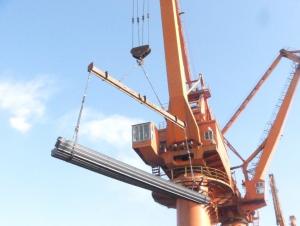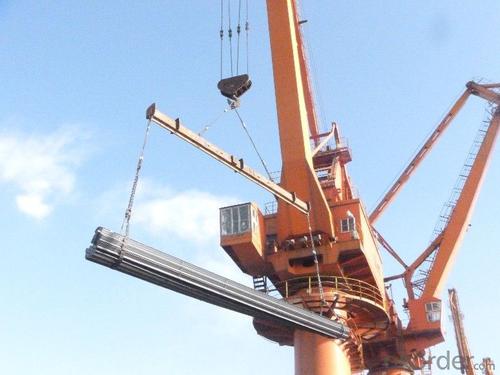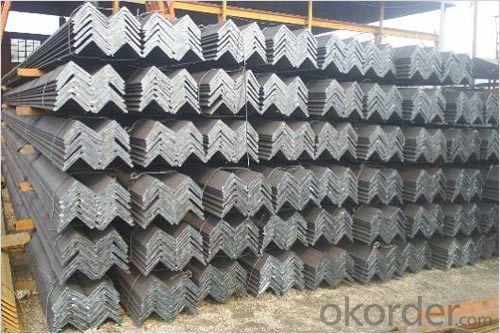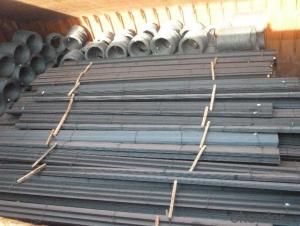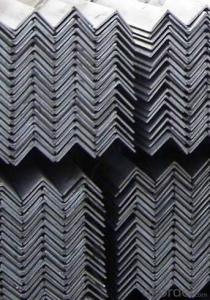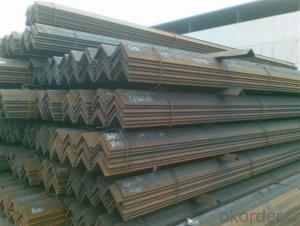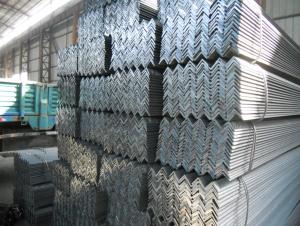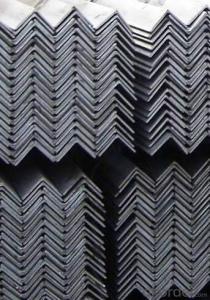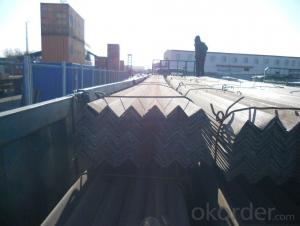GB Standard High Quality Angle Bar
- Loading Port:
- Tianjin
- Payment Terms:
- TT or LC
- Min Order Qty:
- 25 m.t.
- Supply Capability:
- 2000 m.t./month
OKorder Service Pledge
OKorder Financial Service
You Might Also Like
Product Description:
OKorder is offering Angle Steel great prices with worldwide shipping. Our supplier is a world-class manufacturer of steel, with our products utilized the world over. OKorder annually supplies products to European, North American and Asian markets. We provide quotations within 24 hours of receiving an inquiry and guarantee competitive prices.
Product Applications:
According to the needs of different structures, Angle can compose to different force support component, and also can be the connections between components. It is widely used in various building structures and engineering structures such as roof beams, bridges, transmission towers, hoisting machinery and transport machinery, ships, industrial furnaces, reaction tower, container frame and warehouse etc.
Product Advantages:
OKorder's Angle Steelare durable, strong, and resist corrosion.
Main Product Features:
· Premium quality
· Prompt delivery & seaworthy packing (30 days after receiving deposit)
· Corrosion resistance
· Can be recycled and reused
· Mill test certification
· Professional Service
· Competitive pricing
Product Specifications:
1. Invoicing on theoretical weight or actual weight as customer request
2. Length: 6m, 9m, 12m as following table
3. Sizes
Sizes: 25mm-250mm | ||
a*t | ||
25*2.5-4.0 | 70*6.0-9.0 | 130*9.0-15 |
30*2.5-6.6 | 75*6.0-9.0 | 140*10-14 |
36*3.0-5.0 | 80*5.0-10 | 150*10-20 |
38*2.3-6.0 | 90*7.0-10 | 160*10-16 |
40*3.0-5.0 | 100*6.0-12 | 175*12-15 |
45*4.0-6.0 | 110*8.0-10 | 180*12-18 |
50*4.0-6.0 | 120*6.0-15 | 200*14-25 |
60*4.0-8.0 | 125*8.0-14 | 250*25 |
Alloy No | Grade | Element (%) | |||||
C | Mn | S | P | Si | |||
|
|
|
|
|
|
| |
Q235 | B | 0.12—0.20 | 0.3—0.7 | ≤0.045 | ≤0.045 | ≤0.3 | |
|
|
|
|
|
|
| |
Alloy No | Grade | Yielding strength point( Mpa) | |||||
Thickness (mm) | |||||||
≤16 | >16--40 | >40--60 | >60--100 | ||||
≥ | |||||||
|
|
|
|
|
| ||
Q235 | B | 235 | 225 | 215 | 205 | ||
Alloy No | Grade | Tensile strength (Mpa) | Elongation after fracture (%) | ||||
Thickness (mm) | |||||||
| ≤16 | >16--40 | >40--60 | >60--100 | |||
≥ | |||||||
|
|
|
|
|
|
| |
Q235 | B | 375--500 | 26 | 25 | 24 | 23 | |
Quality Assurance of Alloy Steel for Bearing
We are the ISO 9001:2000 authentication enterprises and we can provide the enterprise's quality written guarantee for all the exported products.
Certificate of quality is issued in English, in addition the normal terms, production process, the mechanical property (yield strength, tensile strength, elongation and hardness. forged ratio, UT test result, Grain size, heat treatment methods and the sample of is shown on the certificate of quality.
FAQ:
Q1 How soon can we receive the product after purchase?
A1 Within three days of placing an order, we will begin production. The specific shipping date is dependent upon international and government factors, but is typically 7 to 10 workdays.
Q2: How do we guarantee the quality of our products?
A2: We have established an advanced quality management system which conducts strict quality tests at every step, from raw materials to the final product. At the same time, we provide extensive follow-up service assurances as required.
Q3: How soon can we receive the product after purchase?
A3: Within three days of placing an order, we will begin production. The specific shipping date is dependent upon international and government factors, but is typically 7 to 10 workdays.
Q4: What makes stainless steel stainless?
A4: Stainless steel must contain at least 10.5 % chromium. It is this element that reacts with the oxygen in the air to form a complex chrome-oxide surface layer that is invisible but strong enough to prevent further oxygen from "staining" (rusting) the surface. Higher levels of chromium and the addition of other alloying elements such as nickel and molybdenum enhance this surface layer and improve the corrosion resistance of the stainless material.
Images:
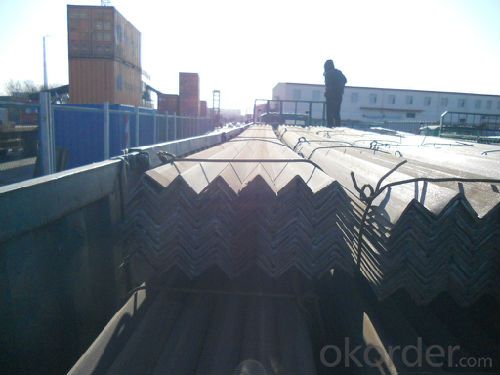
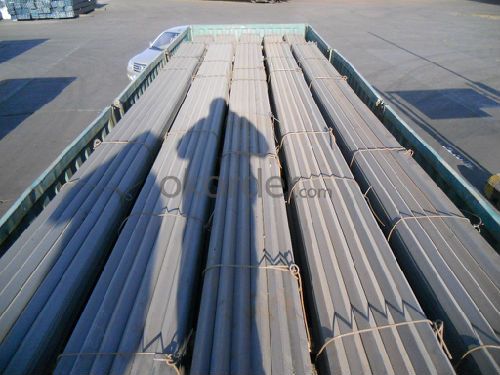
- Q: Can steel angles be used for wall bracing?
- Yes, steel angles can be used for wall bracing. Steel angles are commonly used for this purpose as they provide structural support and stability to walls, ensuring they can resist lateral forces such as wind or seismic loads.
- Q: What are the typical lengths of steel angles available in the market?
- The typical lengths of steel angles available in the market vary depending on the specific needs and requirements of the project. However, there are some common standard lengths that are readily available. These typically range from 20 feet to 40 feet, with incremental measurements such as 20 feet, 25 feet, 30 feet, 35 feet, and 40 feet. These lengths are commonly used in construction and industrial applications where steel angles are utilized for structural support, framing, and bracing purposes. It is important to note that customized lengths can also be obtained through special orders or fabrication, allowing for more flexibility in meeting specific project requirements.
- Q: What is the maximum shear force for a steel angle?
- The maximum shear force for a steel angle depends on various factors such as the material properties, size, and design specifications. To determine the maximum shear force, it is necessary to consult the relevant engineering standards, guidelines, and calculations specific to the particular steel angle being used.
- Q: How do steel angles perform in high-wind regions?
- Steel angles perform well in high-wind regions due to their inherent strength and durability. The angled shape helps distribute wind forces evenly, minimizing the risk of structural failure. Additionally, steel angles can be reinforced with additional supports or bracing to further enhance their performance in high-wind areas.
- Q: How do you determine the appropriate size of steel angle for a specific application?
- To determine the appropriate size of steel angle for a specific application, factors such as the load it needs to bear, the length of the span, the type of material being supported, and any applicable building codes or regulations should be considered. Structural engineers or professionals with expertise in steel construction can perform calculations and analysis to determine the required size of steel angle based on these factors.
- Q: Can steel angles be used for HVAC ductwork?
- No, steel angles are not typically used for HVAC ductwork. Ductwork is commonly made from galvanized steel sheets or flexible materials such as aluminum or fiberglass. Steel angles are more commonly used for structural support or framing purposes.
- Q: Can steel angles be used in lighting or electrical fixtures?
- Yes, steel angles can be used in lighting or electrical fixtures. Steel angles are versatile and can be easily fabricated into various shapes and sizes, making them suitable for a wide range of applications. In lighting fixtures, steel angles can be used as brackets or supports to hold the lighting components securely in place. They provide strength and stability to the fixture, ensuring that it can withstand the weight of the lighting elements. Similarly, in electrical fixtures, steel angles can be used as frames or mounting brackets to hold electrical components such as switches, outlets, or junction boxes. The durability and load-bearing capacity of steel angles make them an ideal choice for these applications, as they can handle the weight and stress associated with lighting or electrical fixtures. Additionally, steel angles can be easily painted or coated to match the aesthetic requirements of the fixture, making them a versatile and practical choice for lighting or electrical applications.
- Q: How do steel angles perform in terms of electromagnetic shielding?
- Steel angles have a reputation for being highly effective in terms of electromagnetic shielding. This is mainly because of their exceptional electrical conductivity and magnetic permeability. These particular qualities enable steel angles to efficiently redirect or absorb electromagnetic waves, resulting in a reduced impact on adjacent electronic devices or sensitive equipment. The shape and geometry of steel angles also play a role in their shielding capabilities, as they can be strategically positioned to create barriers or enclosures that obstruct or redirect electromagnetic fields. Additionally, the thickness or gauge of the steel angle can further amplify its shielding performance. In general, steel angles find widespread use in a variety of applications where minimizing or controlling electromagnetic interference is crucial, such as in the construction, telecommunications, electronics, and automotive industries.
- Q: What are the common shapes and dimensions of steel angles?
- Steel angles are commonly available in a variety of shapes and dimensions to suit various applications. The most common shapes of steel angles are L-shaped or right angles, with equal legs or unequal legs. These angles are typically formed by bending a piece of steel into the desired shape. In terms of dimensions, steel angles can vary in size depending on their intended use. The length of the legs, which are the two sides of the angle, can range from a few inches to several feet. The thickness or gauge of the steel used to make angles can also vary, with thinner gauges being more lightweight and thicker gauges providing greater strength. The most common dimensions for steel angles include: - Equal Leg Angles: These angles have legs of equal length, forming a 90-degree angle. Common sizes for equal leg angles range from 1/2 inch to 6 inches in leg length, with thicknesses ranging from 1/8 inch to 1/2 inch. - Unequal Leg Angles: These angles have legs of different lengths, forming a 90-degree angle. The longer leg is typically referred to as the "vertical leg" and the shorter leg as the "horizontal leg." Common sizes for unequal leg angles range from 1 inch to 6 inches in vertical leg length, with thicknesses ranging from 1/8 inch to 1/2 inch. It's important to note that these dimensions are just a general guideline, and steel angles can be custom-made to meet specific requirements. Additionally, steel angles can be hot-rolled or cold-formed, which affects their structural properties and manufacturing processes. Therefore, it's essential to consult the specific standards and regulations applicable to your project or industry when selecting steel angles.
- Q: Can steel angles be used for stair stringers?
- Yes, steel angles can be used for stair stringers. Steel angles are commonly used in construction for their strength and durability. When used as stair stringers, steel angles provide the necessary support and stability for the stairs. They can be easily cut and welded to the desired shape and size, making them a versatile option for stair construction. Additionally, steel angles are resistant to rot, termites, and other forms of damage, ensuring the longevity of the stair structure. However, it is important to consult with a structural engineer or a professional contractor to ensure that the steel angles meet the specific requirements and load-bearing capacity for the intended stair design.
Send your message to us
GB Standard High Quality Angle Bar
- Loading Port:
- Tianjin
- Payment Terms:
- TT or LC
- Min Order Qty:
- 25 m.t.
- Supply Capability:
- 2000 m.t./month
OKorder Service Pledge
OKorder Financial Service
Similar products
Hot products
Hot Searches
Related keywords
